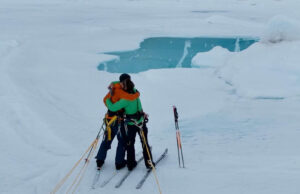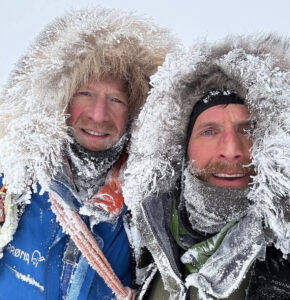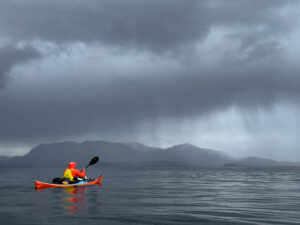After aborting their first attempt at the Northwest Passage in 2022 after just 300km, veteran Texas kayak racers West Hansen, 61, and Jeff Wueste, 63, made some changes: double kayaks instead of singles and two new members — endurance paddler Eileen Visser of New York and ultramarathoner Mark Agnew of the UK.
The foursome also showed up a month earlier, in early July. A snowmobile from Pond Inlet conveyed them to their starting point at the eastern end of Bylot Island, just north of Baffin Island.

The first two weeks of this 2,500km expedition did not look promising.
That early in the season, the sea ice was still solid along Bylot’s south coast, the route they had paddled the previous year. They were kayakers, not arctic travelers, and had little desire to drag their kayaks over the ice to open water. They had not brought either crampons or ski poles to facilitate this sort of travel.
So the Arctic Cowboys, as they styled themselves, sat for nearly two weeks in a little hunting cabin on Bylot Island. If they could only reach the north end of the island, they could begin. There, the strong currents of Lancaster Sound had already cleared away the ice. Once, they made an abortive stab at it, but the swiftly moving floes stymied them. Retreating with difficulty back to the cabin, they waited some more.

Jeff Wueste, left, finishes packing the boat while West Hansen adjusts his icy spray skirt. Photo: The Arctic Cowboys
Bureaucratic hurdle
Finally, the ice had cleared enough for them to escape. Meanwhile, they and their home team wrestled with local bureaucracy. Part of Bylot Island along that northern route is a migratory bird sanctuary. You can’t land there without a permit, which they did not have.
When they finally began to paddle, they took their satellite tracker briefly offline. Perhaps they wanted to avoid leaving evidence that they were landing to camp, contrary to regulations.
“We were not impressed,” a Parks Canada warden in Pond Inlet told me when I visited that small arctic town in mid-August.
But after a few surprisingly fast days, the paddlers had moved beyond the forbidden area, and their tracker was back online again.
Thus ended the very messy beginning. For the next two-and-a-half months, Hansen, Wueste, Mark Agnew, and Eileen Visser did almost everything right.
The warden from Pond Inlet did not think they would succeed. I was less sure. It’s true that they did not seem prepared to deal with sea ice, apart from waiting it out. But the more that climate change turned the Northwest Passage into a colder version of the Gulf of Mexico, Hansen and Wueste’s backyard, the better the chance they had.

A rare sunny, calm day on the water. Photo: The Arctic Cowboys
Some years still impassible
Some summers, sea ice still blocks the Northwest Passage. In 2018, for example, no vessel made it through. Even large ships had to turn back. Other years, the Passage is wide open.
This was one of those summers. I did the Northwest Passage in late August the easy way, as a resource person on a cruise ship. I’ve done the Passage in that capacity half a dozen times. This year for the first time, we saw no sea ice whatsoever.
Once the kayakers had escaped the ice of eastern Bylot, they showed how they differed from other parties who had tried the Passage before them. They were very strong paddlers and routinely covered 60 kilometers or more in a day. On their first four days on the water, they did 64km, 56km, 77km, and 71km. During a more modest stretch about two-thirds through the journey, they made 65km, 67km, 38km, 57km, and 48km. The few slightly slower days signified headwinds.
I asked veteran expedition paddler Jon Turk, now 78, about such impressive mileage.
“Modern techniques and fitness are way above what we brought to the sport,” reflected Turk. “Also, our boats didn’t have the hull speed. Not long ago, I paddled the Arctic in a modern boat. I used to paddle at 2.5 knots. Now I was going 3.5 knots, and I was out of shape. I wondered if my GPS was wrong.”
Turk has often dragged his kayak over sea ice, most notably in 2011, when he and Erik Boomer hauled and paddled their boats completely around Ellesmere Island. Turk always used near-indestructible rotomolded kayaks. High-performance boats today are lighter and faster but don’t take abrasion well, he explained.
Still, they could have dragged their boats on small custom-made sleds, as I have done with my own fragile kayak on occasion. When not in use, it fits nicely over the aft deck.
Did Turk consider his amphibious arctic journeys, two-thirds hauling a kayak, one-third paddling, an actual kayak expedition?
Turk laughed. “People can call it whatever they want,” he said. “I don’t give a shit.”

A chilly camp in early fall. Photo: The Arctic Cowboys
Satellite weather reports
Regular satellite weather reports from the Arctic Cowboys’ home team allowed them to rest when conditions were likely to turn gnarly. They didn’t seem to mind regular two or three-day layovers as the all-too-brief arctic summer yielded to fall. Whenever they were out on the water, their consistent big days allowed them to make up time.
Their biggest day came when they had to cross Prince Regent Inlet from Baffin Island to Somerset Island. Ninety kilometers and some 15 or 16 or 17 hours later, the tired crew beached safely on Somerset. They had other long crossings ahead, but nothing like this one.
A few days later, they transited through narrow Bellot Strait, between the Canadian mainland and Somerset Island. This two-kilometer-wide, 25km-long waterway has such swift currents that you can only paddle it at slack tide or with the tide in your favor. It also marked their passage from the eastern to the western Arctic.

Left to right, Mark Agnew, West Hansen, Jeff Wueste, and Eileen Visser. Photo: The Arctic Cowboys
An open polar sea
No sea ice lay ahead of them. In fact, they even chose to paddle down the western side of King William Island. Back in 1846, Sir John Franklin made that same choice, rather than take the safer eastern side. Franklin’s ships almost immediately became stuck in the ice. He and all 125 remaining men ultimately perished.
But the kayakers had no problems around King William Island. Maintaining their swift pace, they soon reached the town of Cambridge Bay on neighboring Victoria Island. Here, they rested for a week, picked up fresh supplies, and waited for new drysuits to arrive.
Just one big question remained. As the fall equinox approached and the weather became much colder and more unstable, how would these southern kayakers, inexperienced in the Arctic, handle it? They would have to paddle into October when nights were long, the temperatures remained below freezing, and the snow started to accumulate.

As autumn advanced, conditions became much rougher and colder. Photo: The Arctic Cowboys
Other parties
This foursome was not the only self-propelled party attempting the Northwest Passage this year. A pair of kayakers in single rowing hulls had started from the west. One became injured and had to drop out, but Matty Clarke persisted alone until eventually, equipment problems forced him to call it quits on King William Island. He ended his attempt at the island’s lone town of Gjoa Haven — named for the Gjoa, the ship Amundsen used for the first transit of the Northwest Passage. It took Amundsen three years.
Another party to attempt the Passage in 2023 was a group of British rowers. Like the Cowboys, they too started at Pond Inlet, but much later in the season. They rowed in shifts, some at the oars, some sleeping in the boat’s cabin. They too were making good time. Just west of Cambridge Bay, they were not far behind the kayakers when the cold and storms sapped their motivation. They called it off, seemingly for no particular reason except that they were now uncomfortable with the conditions.

The strain of almost three months of hard travel shows on West Hansen’s face. Photo: The Arctic Cowboys
Meanwhile, the kayakers, in much smaller and more delicate craft, continued their intelligent advance. They relied heavily on weather reports from their home team, sat out bad weather, and paddled hard when conditions allowed. The arithmetic made sense: If you can average 60 kilometers a day, you only need to be on the water for 42 days to cover the 2,500km of the Northwest Passage.
Winter closes in
Nevertheless, the last section, from Cambridge Bay to the end of the Northwest Passage, tried their patience. They were tired, and their daily paddling window shrank as the nights lengthened. Early in the trip, you could wait for calm water and launch at 1 am under the midnight sun. Not now.
Their number of tentbound days increased. Once they had to wait five days to paddle three days. Snow began to pile up around their tent. On another occasion, they had to seal launch into five-meter waves. Even at this late stage, not all of them were sure they would make it.
Finally, on October 8, they rounded Cape Bathurst, which marks the end of the Northwest Passage. From here, Amundsen Gulf yawns widely into the Beaufort Sea. No further islands loom to the north of them, and only the Canadian mainland to the south.
They originally planned to finish at Tuktoyaktuk, the nearest town from which their support team could drive them home. Instead, harried now by constant storms, they decided to charter a Twin Otter aircraft to fly them out.

Photo: The Arctic Cowboys
Past attempts
These days, lots of cruise ships and even private sailboats do the Northwest Passage. In spring 2011, Sarah and Eric McNair-Landry kite-skied from Tuktoyaktuk to Pond Inlet, making good use of the prevailing westerlies. A couple of dogsledders, including the great Naomi Uemura, dogsledded the distance. (Uemura actually went from Greenland to Alaska over two seasons.)
In 2013-15, French rower Charles Hedrich rowed from Alaska to Pond Inlet over three summers. But this year marked the first time a party had paddled the entire Passage in a single season. Discounting the McNair-Landrys’ wind-assisted journey, it was the first time anyone had done it under their own steam in one year.
Not everyone agrees, of course, that this was the entire Northwest Passage. One reader of our coverage of this expedition, for example, pointed out that by some definitions, the Northwest Passage runs from Davis Strait, off southern Baffin Island, to the Bering Strait.
That seems a little harsh unless you have a sailboat, because no one is going to ski, kite, row, dogsled, or paddle that much greater distance in a single season. The Arctic Cowboys did the obvious Northwest Passage, the familiar Northwest Passage, and it was a singular, hard journey. Faced with alternative definitions of the legendary waterway, the wisest thing for them is probably just to shrug and say, “I don’t give a shit.”
Editor’s note: This story assumed that they resolved their issue with permits for Bylot Island, mentioned above. In the end, they did not, and have been charged with multiple violations. More details in this followup story.






